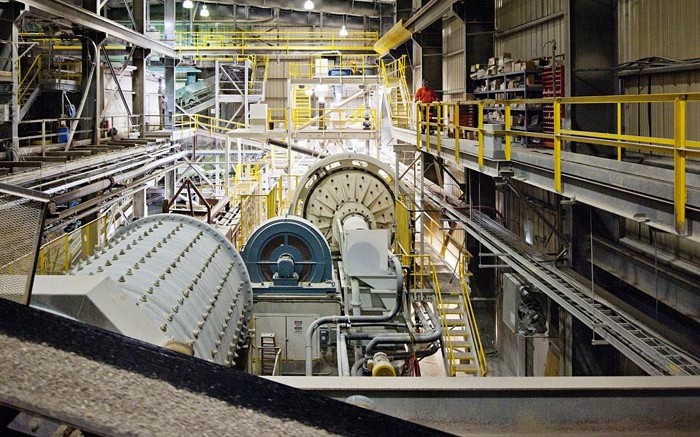With several major zinc mines slated to close in the next few years, zinc prices have responded accordingly — climbing 12% year-to-date and 24% over the last 12 months.
So where does zinc go from here? In a recent note, BMO Capital Markets calculates the metal’s upside and downside potential and concludes that while any upside left for zinc prices is limited, so are the downside risks.
BMO estimates that the closure of large mines over the next few years, including Century in Australia and Lisheen in Ireland next year, will remove 800,000 tonnes per year from the 13-million-tonne-per-year zinc market by 2018.
However, the investment bank says that those favourable fundamentals are already baked into the zinc price.
Still, BMO expects bullish markets regarding zinc to keep the price near its level of US$1.04 per lb. at the time the report was issued (That price, BMO notes, is well ahead of the ninetieth percentile of the cash cost curve, meaning that most zinc producers should be cash-flow positive right now.) At press time, zinc had a US$1.08 spot price.
Despite the looming closures, BMO doesn’t foresee a large supply-demand gap in the near-term for zinc, which is primarily used to make galvanized steel. The bank sees a relatively tight market for zinc that is balanced this year and will grow to a modest surplus next year (138,000 tonnes, or 1% of the global market). Restarts and expansions of both primary zinc mines and by-product operations are expected to make up for lost production from shuttered mines until 2018, when BMO forecasts a market deficit for zinc.
There is some downside risk for zinc in the meantime — primarily from expansion of Chinese supply.
“As China accounts for around 30% of mined zinc supply and 40% of smelting output, its ability to ramp up production quickly could reverse the positive outlook for market fundamentals,” BMO mining analyst Aleksandra Bukacheva and research associates Luigi di Pede and Milovan Pejic write in a research report.
In a conservative base-case scenario, BMO expects Chinese zinc mine supply will grow at a compound annual growth rate (CAGR) of 1.5% through 2018.
But given that Chinese zinc production ballooned from 2009–12 with a surprisingly strong CAGR of 15%, it’s possible the country can ramp up production and stamp down zinc prices.
“At stronger zinc prices, BMO Research understands that there is potential for 1.2 million tonnes per year of incremental zinc mine capacity (8–8.5% of the global market) to start up quickly,” reads the note.
BMO forecasts that zinc will average US98¢ a lb. this year, increasing gradually to US$1.10 per lb. in 2018.
Assuming that zinc prices stay strong, there are few companies that offer investors meaningful leverage to the zinc price, BMO notes.
However, the bank has initiated coverage on two companies whose share prices could see a boost with higher zinc prices: Nyrstar (OTC: NYRSY) and Boliden (OTC: BDNNF). Both are vertically integrated companies with zinc mines and smelting facilities.
Nyrstar’s “main attraction” is leverage to zinc prices. Zinc represents more than 75% of the company’s revenues, and BMO notes that a 10% increase in the zinc price above US$1 per lb. would mean a more than 80% jump to Nyrstar’s expected earnings per share and net present value in 2015. While its mines have underperformed, the company is focusing on cost control and optimization of its operations, as well as a €338-million investment in its Port Pirie smelter that could enhance its earnings from the smelting operations starting in 2017.
As for Boliden — a more diversified company with a stronger balance sheet — BMO forecasts that the company will more than triple its earnings by 2017, thanks to rising copper and zinc production, an expansion in smelting capacity and cost-cutting efforts. Zinc represents 30% of the company’s expected earnings for 2014.
BMO has an “outperform” rating on Boliden and a SEK 135 target price, and a “market perform” rating on Nyrstar with a €3.50 target price. The companies recently traded at SEK 111.6 and €2.56.
Another name that’s poised to benefit from strong zinc prices is Nevsun Resources (TSX: NSU; NYSE-MKT: NSU). Canaccord Genuity mining analyst Rahul Paul recently raised his 12-month target for the Africa-focused miner to $5 from $4.50. Nevsun shares recently traded at $3.38.
Canaccord recently revised its long-term metal prices (looking out to 2019 and beyond) with gold, silver and copper all revised slightly lower (down 0.6–1.2%), and zinc gaining 7.9% to US$1.01 per lb.
Nevsun’s Bisha open-pit mine in Eritrea contains copper, gold, silver and zinc, and is expected to produce zinc in 2016. Canaccord forecasts Nevsun’s sole mine will produce 146 million lb. zinc in 2016, increasing to 208 million lb. zinc in 2017.


Be the first to comment on "BMO looks for leverage to soaring zinc price"